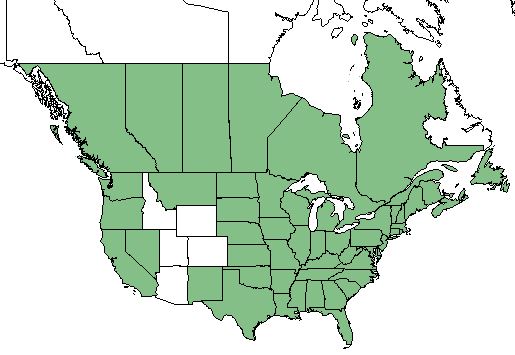Oenothera biennis
Common name: common evening primrose[1]
| Oenothera biennis | |
|---|---|

| |
| Photo by John Hilty at IllinoisWildflowers.info | |
| Scientific classification | |
| Kingdom: | Plantae |
| Division: | Magnoliophyta - Flowering plants |
| Class: | Magnoliopsida - Dicots |
| Order: | Myrtales |
| Family: | Onagraceae |
| Genus: | Oenothera |
| Species: | O. biennis |
| Binomial name | |
| Oenothera biennis L. | |

| |
| Natural range of Oenothera biennis from USDA NRCS Plants Database. | |
Contents
Taxonomic Notes
Synonyms: Oenothera biennis var. biennis[2]
Varieties: Oenothera biennis var. pycnocarpa (Atkinson & Bartlett) Wiegand[2]
Description
O. biennis is a biennial forb/herb of the Onagraceae family native to North America and Canada.[1] Its leaves are green to pale green and the stems, ovary, floral tube, and sepals sparsely appressed-pubescent. Its fruit is terete, thickest near the base, and tapering to the apex. The capsules are colored gray-green or dull green while the seeds are borne horizontally in the locules, angled-prismatic, and not regularly pitted. There should be 50 to many seeds per capsule, all 0.3-2 mm long. The inflorescence is erect at the apex and the flower is yellow. The petals are 0.7-2.5 cm long, the stigma is surrounded by or below the anthers, the stamens are all equal in length, and the sepals are erect in the bud.[2]
Distribution
O. biennis is found in all of the United States and Canada excluding Idaho, Wyoming, Utah, Colorado, and Arizona.[1]
Ecology
Habitat
O. biennis proliferates in fields, pastures, roadsides, and disturbed areas.[2] Specimens have been collected from dry loamy sands, moist loamy sands, disturbed roadsides, trail clearings, the edges of old field habitat, road embankments, wet pinewood borders, the open bank of marshes, old fields, along the roads in hardwood forests, and parking area edges.[3]
Phenology
O. biennis flowers from June through October.[2]
Fire ecology
O. biennis is not fire resistant and has low fire tolerance;[1] despite this, populations on the Wade Tract of south Georgia have been known to persist through repeated annual burning.[4]
Herbivory and toxicology
Oenothera biennis has been observed to host aphids such as Aphis sp. (family Aphididaea), bees such as Bombus ternarius (family Apidae), stilt bugs such as Jalysus sp. (family Berytidae), and leafhoppers from the Cicadellidae family such as Agallia sp., Empoasca sp., and Scaphytopius sp., sweat bees from the Halictidae family such as Agapostemon sericeus, Lasioglossum macoupinense and L. oenotherae, and plant bugs from the Miridae family such as Lygus lineolaris and Pseudatomoscelis seriatus.[5]
Conservation, cultivation, and restoration
O. biennis is listed as a weedy or invasive plant by the University Press of Kentucky, the Nebraska Department of Agriculture Bureau of Plant Industry, and the Southern Weed Science Society.[1]
Cultural use
Evening-Primroses can be used as a potherb for their asparagus-like quality of greens, and Native Americans would use the pith to make soup. In England, there was a problem of using the leaves as a tea filler.[6]
Photo Gallery
References and notes
- ↑ 1.0 1.1 1.2 1.3 1.4 USDA Plant Database https://plants.usda.gov/core/profile?symbol=OEBI
- ↑ 2.0 2.1 2.2 2.3 2.4 Weakley, A.S. 2020. Flora of the Southeastern United States. Edition of 20 October 2020. University of North Carolina at Chapel Hill, Chapel Hill, North Carolina.
- ↑ URL: http://herbarium.bio.fsu.edu. Last accessed: June 2018. Collectors: Loran C. Anderson, K. Craddock Burks, Gary Knight, R.K. Godfrey, Wilson Baker, Lisa Keppner, Ed Keppner, R.Komarek, Robert Lazor, Andre Clewell, Miguel Altieri, J.M. Kane. States and counties: Florida (Franklin, Nassau, Leon, Jefferson, Jackson, Madison, Wakulla, Liberty, Bay, Lee, Washington, Gulf.) Georgia (Grady, Thomas, Decatur)
- ↑ Platt, W.J., R. Carter, G. Nelson, W. Baker, S. Hermann, J. Kane, L. Anderson, M. Smith, K. Robertson. 2021. Unpublished species list of Wade Tract old-growth longleaf pine savanna, Thomasville, Georgia.
- ↑ Discoverlife.org [1]
- ↑ Fernald, et al. 1958. Edible Plants of Eastern North America. Harper and Row Publishers, New York.